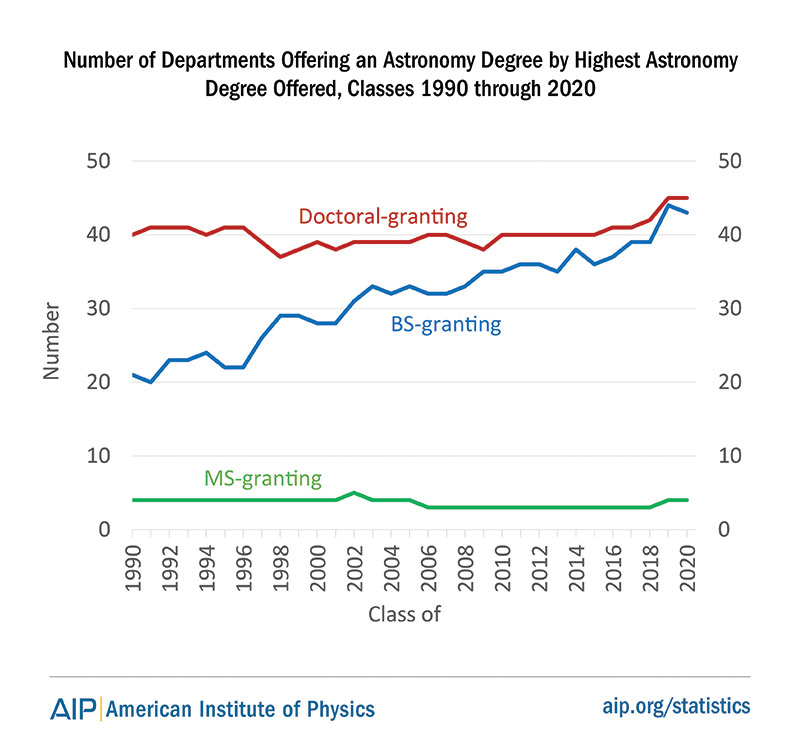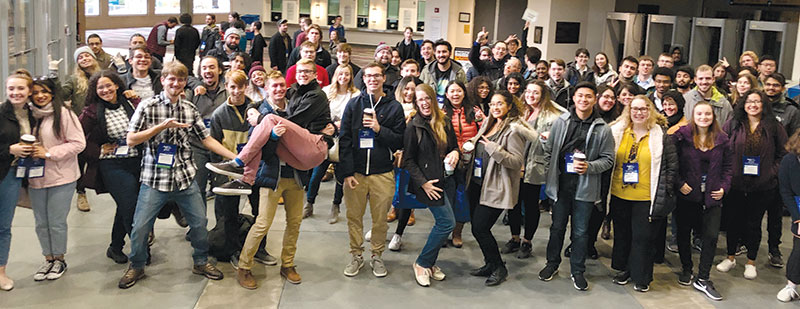Sigma Pi Sigma, The Physics and Astronomy Honor Society
Spring
2022
Feature
Sigma Pi Sigma, The Physics and Astronomy Honor Society
the SPS Governance Committee: Julia Bauer, Shannon Clardy, Brad Conrad, Van Haslett, Larry Isenhower, Taylor Knapp, and Emma Rasmussen
Sigma Pi Sigma has strived for 100 years to support those who study physics and astronomy.1 But as we approached its centennial celebration, society leaders recognized that for all of those students to know that they belong in SPS and Sigma Pi Sigma, we must be explicit and intentional about including astronomy in our communications and governing documents.
Astronomy has been explicitly mentioned—hand-in-hand with physics—in many communications dating back to our founding, such as in the 1931 recommendations on physics and astronomy texts.2 We state loudly and clearly that Sigma Pi Sigma was founded to support physicists and astronomers. To best achieve this goal, both societies need to be explicit and intentional in their support of everyone under the umbrella of SPS and Sigma Pi Sigma.
SPS goes by a variety of names on its diverse campuses, such as Physics and Astronomy or PandA, Women in Physics or WiP, Physics Club, Departmental Undergraduate Group or DUG, and, of course, SPS, and they all support those with an interest in physics and astronomy. Yet it has come to the attention of the SPS leadership that astronomy students may feel less welcome in our community.
Changes to governing documents
To remedy this, during the September 2021 meeting of the SPS National Council, SPS leaders proposed changes to the SPS bylaws and constitution to make completely clear that the societies are for students who have an interest in physics and astronomy and to support them in their education and as SPS members. This means that we also support astronomy and astrophysics clubs as part of SPS. The SPS National Council’s governance committee wrote the following rationale:
While Sigma Pi Sigma has strived for almost 100 years to support those who study physics and astronomy, the society should be explicit in its support of the students within Physics and Astronomy so that everyone knows they belong within SPS and Sigma Pi Sigma. It has come to the attention of the Society of Physics Students that those with an interest or focus in Astronomy may not feel included within our society. Going back to our founding1-3 documents, the intention has always been to support students who study within physics and astronomy departments.
The National Council unanimously approved the proposed changes in the fall of 2021. Early in 2022, all SPS chapters were asked to vote on these constitutional changes. Chapters overwhelmingly supported and welcomed astronomy students with votes of approval.
The parent organization of SPS and Sigma Pi Sigma, the American Institute of Physics (AIP), also fully supports these changes. “Coming from the astronomy community, this acknowledgement by SPS and Sigma Pi Sigma is personally important to me,” says Michael Moloney, the CEO of AIP. “This affirmation of inclusivity can only serve to strengthen budding astronomers’ and astrophysicists’ affinities with SPS and their member communities. The move further underscores SPS’s overarching culture of inclusion—all those who pursue the physical sciences are welcome, and AIP is committed to their journey.”
The physics–astronomy connection
The fields of physics and astronomy are a closely coupled set within the physical sciences. Observations of the universe have led people to seek an understanding of the world around them and often bring people into the world of physics. Those who study physics frequently come to a deep appreciation for the vastness of space and the incredible processes that occur around us. Neither field would be where it is today without the other. New generations of instruments and detectors, enabled by modern technology, are gathering so much raw data that we need an increasing number of scientists to study and learn from this new information. With their long history of data collection and analysis, astronomy departments are rising to the challenge.
To SPS and Sigma Pi Sigma director Brad Conrad, there is a very clear connection between physics and astronomy. “Astronomy is a cornerstone of physics. The search for what was beyond the world we can easily touch has led to scientific wonders and our modern world. Astronomy is physics and physics is astronomy.”
The number of undergraduates earning bachelor’s degrees in physics is at an all-time high, reaching 9,296 in 2020. So, too, is the number of students earning bachelor’s degrees in astronomy, reaching 820 in 2020. As of 2020 there were 52 combined physics and astronomy departments and 43 stand-alone astronomy departments.4 The mission of SPS is to help all of these students, as well as those from stand-alone physics departments, transform themselves into contributing members of the professional community.

What do these changes mean?
The Society of Physics Students and Sigma Pi Sigma won’t change their names, but Sigma Pi Sigma has officially become the “physics and astronomy honor society.” The language on the SPS and Sigma Pi Sigma websites and in print publications will shift to reflect the inclusion of astronomers and astronomy students.
Additionally, the Society of Physics Students is more explicitly supporting astronomy students. Collegiate astronomy clubs will have the option to associate or more formally merge with the SPS chapter at their institution, or form a new SPS chapter if their university does not already have one.
Becoming an SPS member gives astronomy students access to all of the resources and funding opportunities provided through the SPS and Sigma Pi Sigma National Office. The SPS Executive Committee, in consultation with the SPS National Council and SPS National staff, is exploring how to best serve astronomy-focused students and faculty with new or updated SPS resources and opportunities.
SPS will make intentional efforts to recognize and honor the important contributions of astronomers to our understanding of the universe, including with induction into Sigma Pi Sigma. We also hope that chapters will honor many more astronomy students through induction into their local Sigma Pi Sigma chapter, or through a new chapter if one doesn’t already exist at their institution.
As part of this large and ongoing effort, SPS will collaborate with the American Astronomical Society (AAS) and its members to ensure that we have a welcoming and inclusive environment for astronomy-focused students. Kevin Marvel, the CEO of AAS and a long-time friend of SPS, says, “It is truly an honor to have astronomy now intentionally included in SPS and Sigma Pi Sigma . . . having astronomy specifically called out in their foundational documents will welcome those identifying more closely with astronomy and let them know they can join and support SPS and Sigma Pi Sigma.” Marvel is also looking forward to collaborating with SPS and Sigma Pi Sigma “to bring the excitement of astronomy to more people than ever before.” Going forward, SPS will expand its events for astronomy students and faculty attending AAS meetings.
Plans are currently underway for a broad announcement of this change to reach all US physics and astronomy departments. This will be done in coordination with SPS, AIP, and AAS.
SPS wants every undergraduate student with an interest in physics and astronomy to excel. We seek to assist every undergraduate department in helping its students succeed. It is our hope that in the next 100 years, Sigma Pi Sigma and SPS can support astronomy programs and their students at the same level that it has supported physics programs and their students over the last 100 years.
What comes next? It turns out a whole lot! While this change is an affirmation of the original intent of the founding organization and documents, the implications are far reaching and will take time to implement.
It will take years, lots of hard work on the part of the National Council, and many discussions to build the inclusive community we set out to 100 years ago, but the Society of Physics Students and Sigma Pi Sigma, the physics and astronomy honor society, is up for the challenges ahead!
References
1. “Honorary Members,” Radiations of Sigma Pi Sigma, vol. 1, no. 1, October 1930, 19.
2. D. W. Cornelius and Ralph Weatherford, “Recent Textbooks for Advanced Undergraduates and Graduate Students,” Radiations of Sigma Pi Sigma, vol. II, no. 1, December 1931, 58.
3. Sanford Gladden, “The Largest Telescope in the World,” Radiations of Sigma Pi Sigma, vol. III, no. 1, September 1932, 30.
4. Starr Nicholson and Patrick J. Mulvey, Roster of Astronomy Departments with Enrollment and Degree Data, 2020: Results from the 2020 Survey of Enrollments and Degrees (College Park, MD: American Institute of Physics, Statistical Research Center, 2020).

